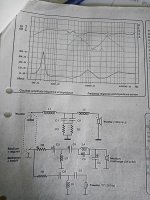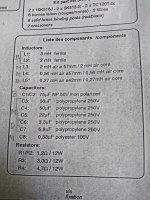Hi!
I have old loudspeakers, Focal Kit C800, with Focals filter. According to the documentation, the crossover slopes 18dB/oct. Would like to update the crossovers to newer and "better" components.
Regarding the filter design. Is this an standard design? Would appreciate some info about the used design.
All the components are, at least what I think, quite large value components.
For instance:
The low pass filter for the base has quite large caps, two 75uF in parallel. New ones, non-electrolyte, this large can be difficult to find and expensive.
Is it possible to scale down the filter values so that smaller value components are used? How will this effect the sound.
Maybe update the filter design - start from scratch? Preferable filter design?
Are there any recommended filter designs/layout regarding sound quality (and price)?
Thanx in advance
Roy
I have old loudspeakers, Focal Kit C800, with Focals filter. According to the documentation, the crossover slopes 18dB/oct. Would like to update the crossovers to newer and "better" components.
Regarding the filter design. Is this an standard design? Would appreciate some info about the used design.
All the components are, at least what I think, quite large value components.
For instance:
The low pass filter for the base has quite large caps, two 75uF in parallel. New ones, non-electrolyte, this large can be difficult to find and expensive.
Is it possible to scale down the filter values so that smaller value components are used? How will this effect the sound.
Maybe update the filter design - start from scratch? Preferable filter design?
Are there any recommended filter designs/layout regarding sound quality (and price)?
Thanx in advance
Roy
Attachments
Nice drivers, I put few smaller Focal kits and couldn't make better without going total crazy redesign and it didn't sound much better, just slightly different. So I just end up re-tuning it slightly to my liking (more laid back) namely by changing slightly tweeter resistor and cap values. The two 75uF, 150uF total if their internal resistance increased could be changed to new or Mylar or combination of both in parallel to lower ESR - putting polypropylene is expensive and you won't gain anything. I remember Elliot from Zalytron sold nice SCR 630V Poly caps, Axon resistors - nice thick solid leads.
Most of the capacitors are Poly which don't change ESR like electrolitics, midrange inductors are Air core - I would just leave it alone unless you want re-tune them and have all the needed measuring equipment to model the x-overs in something like Vituix. The only thing I would do, is bi-wire the woofer and midbass/tweeter into two sections, so I could run the woofers from another amp or with thicker cables than rest.
Most of the capacitors are Poly which don't change ESR like electrolitics, midrange inductors are Air core - I would just leave it alone unless you want re-tune them and have all the needed measuring equipment to model the x-overs in something like Vituix. The only thing I would do, is bi-wire the woofer and midbass/tweeter into two sections, so I could run the woofers from another amp or with thicker cables than rest.
Use electrolytic for the larger values. This crossover has been done with some care so it would be a shame to mess with it for only that reason.
Thanx for your reply.
The original crossovers designed and built by Focal is to be left as is. They are using Axon True cap, JM lab (?) resistors, bought 1999. By the way they are build for bi-wiring. Have been using separate wires from poweramp to base and mid/tweeter. (Using modified JLH 2003 poweramp and preamp both built by me).
I want to build new crossovers with new updated components.
Really love the drivers. Have tested building new crossover with the same values as the original Focal crossovers. Used for base: Jantzen CrossCap, Mid: Mundorf MCap EVO Oil, Tweeter: Jantzen Z-Cap. So much better sound! As for coils, used Mundorf.
Of course, the new crossovers needs to be re-tuned! but the results so promising that I want to take it further and do a proper job this time.
Vituix sounds interesting, will check it out. What equipment is needed? I do have an oscilloscope. Unfortunately the signal generator broken but can get one if needed. Will signal from soundcard do? Anything else? Any pointers on documentation, Howto etc?
Tried to install Vituix but Windows blocks the installation.... Might prefer to run it in Linux but want to be sure it is safe first.
/Roy
The original crossovers designed and built by Focal is to be left as is. They are using Axon True cap, JM lab (?) resistors, bought 1999. By the way they are build for bi-wiring. Have been using separate wires from poweramp to base and mid/tweeter. (Using modified JLH 2003 poweramp and preamp both built by me).
I want to build new crossovers with new updated components.
Really love the drivers. Have tested building new crossover with the same values as the original Focal crossovers. Used for base: Jantzen CrossCap, Mid: Mundorf MCap EVO Oil, Tweeter: Jantzen Z-Cap. So much better sound! As for coils, used Mundorf.
Of course, the new crossovers needs to be re-tuned! but the results so promising that I want to take it further and do a proper job this time.
Vituix sounds interesting, will check it out. What equipment is needed? I do have an oscilloscope. Unfortunately the signal generator broken but can get one if needed. Will signal from soundcard do? Anything else? Any pointers on documentation, Howto etc?
Tried to install Vituix but Windows blocks the installation.... Might prefer to run it in Linux but want to be sure it is safe first.
/Roy
Vituix will run on Linux with Wine, or in a virtual machine.
You'll want some measurement software and a microphone that plugs into your soundcard.
You'll want some measurement software and a microphone that plugs into your soundcard.
I want to sincerely thank pliedtka and especially AllanB for their insightful, generous answers and for sharing their deep knowledge.
Keep Multi-Waying and finding the true sound from your drivers!
Roy
Keep Multi-Waying and finding the true sound from your drivers!
Roy
Last edited:
I use ancient Clio and their microphone with calibration data - it's almost plug and play. The Clio Pocket is what I would recommend today, given many use laptops - there's separate thread on our forum dedicated to Clio. There's also ARTA which allows for MLS measurements but you will need to build jig for it and have older spare PC dedicated just for the audio measurements, so once the ARTA is set up you don't change the soundcard settings - the safest way. REW does sinusoidal and T/S measurements but I don't know about it's MLS capabilities. Again good microphone with calibration data is nice to have. I bought used RST1000A prepolarizedv1/4" lab grade microphone (needs Constant Current Supply) and Clio mic is within 0.5dB from it. The U-mik may not be the best for impulse based measurements as the latency plays it's role, so better to use standard microphone with preamp/soundcard.
You would have to do some research.
Strange Windows blocks Vituix, but then I don't use Win10 for my audio PC as they use XP, Win7 and are not connected to the web to avoid changes in set up from updates, etc. Try to install Vituix in administration mode. On my PCs I can run it from USB stick.
You would have to do some research.
Strange Windows blocks Vituix, but then I don't use Win10 for my audio PC as they use XP, Win7 and are not connected to the web to avoid changes in set up from updates, etc. Try to install Vituix in administration mode. On my PCs I can run it from USB stick.
Last edited:
Also for quick simulation XSim is very useful, as it does Min Phase transform on the fly. But Vituix is hard to beat once you master the awesome tools it provides. Troels uses SPLCad. Bohdan Raczyński offers SoundEasy package which has good measurement capabilities, but I didn't upgrade mine in decades. XMachine is another soft with x-over capabilities but I haven't tried it yet.
- Home
- Loudspeakers
- Multi-Way
- New filter Focal Kit C800

